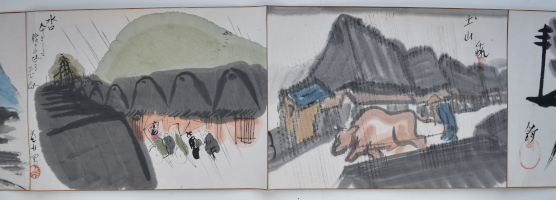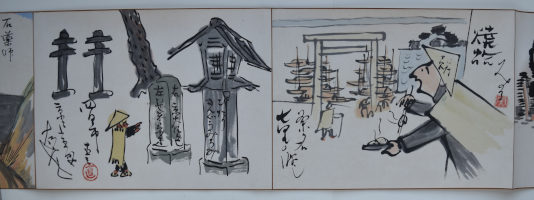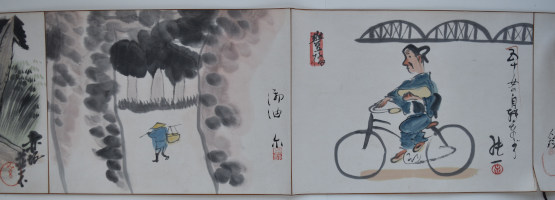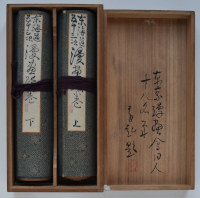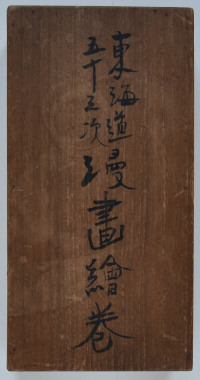Kitagawa FUJIMARO (1790-1850)

Click here to view image full size.
An original painting, full colour on silk, image size 35.25 x 13.5 in; 89.5 x 34.5 cms. Fujimaro was a talented late pupil of Utamaro. More than a dozen paintings are recorded by him including an example in the Portland Art Museum, acc. number 69.51. His best-known work is in the collection of the Tokyo National Museum depicting Yujyo risshi-zu and another four paintings of beauties in the four seasons is in the collection of the Ota Memorial Museum of Art, Tokyo. Shows a standing courtesan beside a vase containing peonies and cherry blossom. On her sumptuous costume are the black wheels of a hanaguruma, “flower cart.” These vehicles carried baskets with often elaborate arrangements of flowers. It seems more than coincidence that the vase is placed where the basket would have been on the cart.
Painted c 1820. Signed Fujimaro with seal Yozan. Newly remounted and in fine condition with new box and futo-maki (thick wooden roll to preserve the painting from damage).
Status: Available
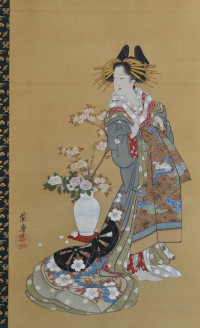
Click here to view image full size.
Kikukawa EIZAN (1787-1867)

Click here to view image full size.
An original painting by Eizan, sumi and full colour on silk, 37 x 13 in; 94 x 33 cms. Eizan was the leading exponent of bijinga in the early 1800s. He founded the Kikukawa School with Eisen his best known pupil. He was left-handed which was somewhat unusual. Shows a standing geisha, her shamisen case at her feet. This musical instrument was frequently associated with the world of courtesans.
Very minor marks, otherwise very good condition. Signed Kikukawa Eizan with seals Kikukawa Toshinobu.
Status: Available
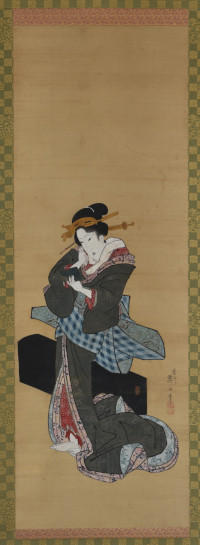
Click here to view image full size.
Matsumura GOSHUN (1752-1811)
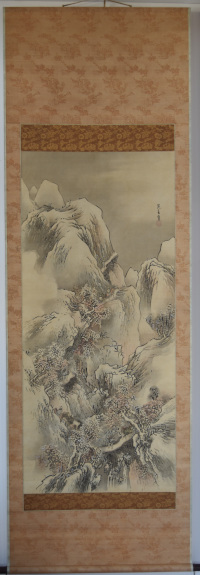
Click here to view image full size.
An original painting, sumi and light colour on silk, 49 x 22 in; 124.5 x 56 cms. Shows a mountainous landscape in snow with figures on a narrow footpath between overhanging cliffs. Goshun was a highly influential artist, known for his geniality and mastery, not only of painting, but of poetry and calligraphy. A pupil of Yosa Buson and then much influenced by Okyo. Founded the Shijo School (named after the street on which he lived in Kyoto). His mature style dates from around 1795.
A large and excellent example of his work in very good condition. Signed Goshun utsusu with seal Goshun.
Status: Available
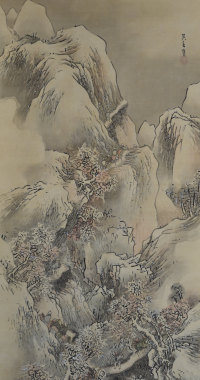
Click here to view image full size.
Maekawa SENPAN (1888-1960); Okamoto IPPEI (1886-1948); Kondo KOICHIRO (1884-1962) et al
Click here to view image full size.
A set of two handscrolls in original paulownia storage box, 30 feet x 10 in; 914.4 x 25.4 cms. Sumi and full colour on paper by 18 artists of the Tokyo Manga Association, produced in 1921: 27 paintings in scroll 1; 28 paintings in scroll 2. The scrolls are a modern manga rendering of the Tokaido Road in homage to Hiroshige, the artists following and interpreting the same route that Hiroshige walked. Satirical and comedic showing the modernisation of Japan at a time manga was gaining popularity due to publications like the Jiji Manga newspaper supplement, previously known as the Ponchi, “Punch.” 150 sets were produced (although some sources give as many as 250-300 being made). No two sets are exactly the same ; indeed, some artists changed their designs substantially. Tokaido gojusan-tsugi Manga emaki, “Manga Handscrolls of the Fifty-three Stations of the Tokaido Highway.” Inside lid inscription: Tokaido emaki, dojin juhachi mei hitsu, “Tokaido handscrolls, painted by eighteen members.” Tokyo Chuo Bijutsukai dated Taisho 10 (1921).
A fascinating historical document. Some slight separation in the scrolls, but otherwise in very good condition. Various signatures and seals.
Status: Available
Eishosai CHOKI (Active c. 1781-1813)
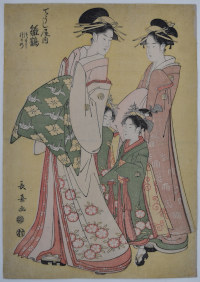
Click here to view image full size.
A yellow ground aiban showing the high-ranking courtesan Hinazuru of the Chojiya House with her two kamuro Tsuruji and Tsuruno. Little is known of his life: Probably a pupil, together with Utamaro, of the artist Toriyama Sekien. His output was limited, leaving a small corpus of work, but some acknowledged masterpieces. Signed with two go: Choki, in the style of Kiyonaga, and Shiko in the style of Utamaro. Published by Murataya Jirobei (Eiyudo) c. 1795.
Fine impression. Very good colour. Centre fold only evident au verso, otherwise very good condition. Signed Choki ga.
Status: Available
Utagawa HIROSHIGE (1797-1858)
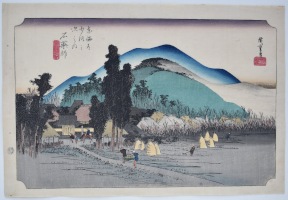
Click here to view image full size.
Station Ishiyakushi from Tokaido gojusan-tsugi no uchi, “Fifty-three Stations of the Tokaido.” This seminal work was possible because Hiroshige was asked to accompany an official procession along the Tokaido Road from Edo to Kyoto in 1832, and he made numerous sketches to document the journey. An evening scene in late autumn showing the village with the Ishiyakushi-ji (temple) on the left. This housed a stone image of Yakushi Nyurai, the Buddha of medicine. Pilgrims came in the hope of being healed, but they seldom stayed preferring to move on to Shono, the next station, which was only 3 km away. Because of the sets popularity, it was reprinted many times and there are a plethora of late impressions. Early printings are hard to find. Published by Hoeido (Takenouchi Magohachi) and Tsuruya Kiemon (Senkakudo) 1833-34.
Fine, early impression. Beautiful blue bokashi on the distant Suzuka Mountains: Late impressions often have crude wiping of this block. Fine colur and condition. Signed Hiroshige ga.
Status: Available
Utagawa HIROSHIGE (1797-1858)
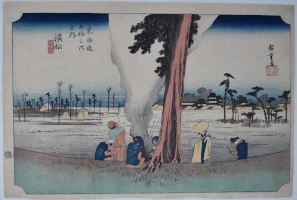
Click here to view image full size.
Station Hamamatsu from Tokaido gojusan-tsugi no uchi, “Fifty-three Stations of the Tokaido.” This seminal work was possible because Hiroshige was asked to accompany an official procession along the Tokaido Road from Edo to Kyoto in 1832, and he made numerous sketches to document the journey. A winter scene with farmers warming themselves around a fire. Hamamatsu Castle in the distance. Because of the set’s popularity, it was reprinted many times and there are a plethora of late impressions. Early printings are hard to find. Published by Hoeido (Takenouchi Magohachi) and Tsuruya Kiemon (Senkakudo) 1833-34.
Fine, early impression. Fine colour and condition. Signed Hiroshige ga.
Status: Available
Utagawa HIROSHIGE (1797-1858)
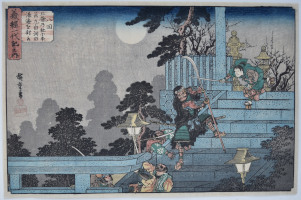
Click here to view image full size.
Ushiwakamaru (Yoshitsune) defeats the priest Tankai of Shirakawa at the Gojo Shrine under a full moon. Hachikai, Gojo no Yashiro ni Ushiwakamaru Shirakawa no Tankai o uchitori from the set Yoshitsune ichidaiki no uchi, “The Life of Yoshitsune.” Published by Tsuruya Kiemon (Senkakudo) 1832-34.
Fine impression and colour. Very good condition. Signed Hiroshige ga.
Status: Available
Katsukawa SHUNSHO (1726-1792)
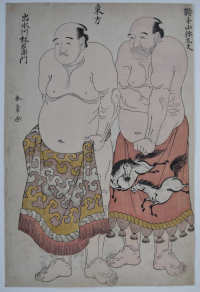
Click here to view image full size.
Two sumo wrestlers from the East Side: Kurateyama Yadayu (right) and Izumigawa Rin’emon (left) from a fine set of double portraits: 5 from the West Side, 6 from the East Side. No publisher’s seal but probably published by Toyoshimaya Bunjiemon (Bunkindo) c. mid 1780s.
Fine impression. Very good colour and condition. Signed Shunsho ga.
Status: Available
Utagawa HIROSHIGE (1797-1858)
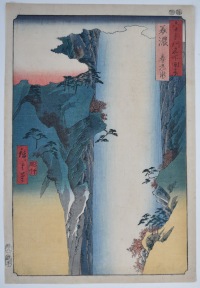
Click here to view image full size.
The Yoro Waterfall. Mino, Yoro no taki, “Mino [Province], Yoro Waterfall” from Rokujuyoshu meisho zue, “Famous Views of the Sixty-odd Provinces.” The 32 meters fall cascades down from Mount Tado. Legend has it that the water had rejuvenating properties with the Empress Gensho (A.D. 683-748) having visited and likening the taste to that of sake. A cider, Yoro Sanroku, is produced here. Published by Koshimuraya Heisuke (Kohei), 1853-56, this being 1853. Numerous states exist of this design with colour variations and differences in gradation. Primarily the colouring of the fall changes: Some impressions have the waterfall completely blue, which obscures the blind-printing, while others, as here, have edge gradation only.
Very good impression with blind-printing on the waterfall. Fine colour. Very good condition. Signed Hiroshige ga.
Status: Available
Utagawa HIROSHIGE (1797-1858)
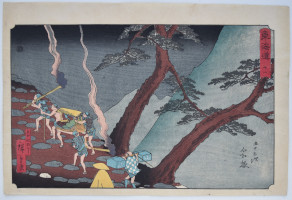
Click here to view image full size.
Station Hakone from a set Tokaido gojusan tsugi, “The Fifty-three Stations of the Tokaido Road,” aka the Reisho Tokaido from the clerical script used in the title, or the Marusei Tokaido after the publisher Maruya Seijiro (Marusei) who published the set 1847-52. Hakone, yonaka taimatsu tori, “Hakone, Travelling with Pine Torches at Night.” Porters lighting the way for a palanquin with firebrands on a mountain path. A beautiful design.
Very fine impression with strong woodgrain. Fine colour and condition. Signed Hiroshige ga.
Status: Available
Utagawa HIROSHIGE (1797-1858)
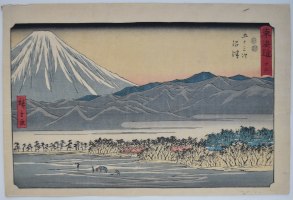
Click here to view image full size.
Station Numazu from a set Tokaido gojusan tsugi, “The Fifty-three Stations of the Tokaido Road,” aka the Reisho Tokaido from the clerical script used in the title, or the Marusei Tokaido after the publisher Maruya Seijiro (Marusei) who published the set 1847-52. An impressive view of Mount Fuji seen from the plains of Suruga. The village of Numazu is seen on the right amongst the trees.
Very fine impression. Fine colour and condition. Signed Hiroshige ga.
Status: Available
Utagawa HIROSHIGE (1797-1858)
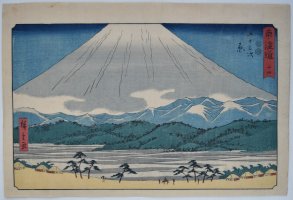
Click here to view image full size.
Station Hara from a set Tokaido gojusan tsugi, “The Fifty-three Stations of the Tokaido Road,” aka the Reisho Tokaido from the clerical script used in the title, or the Marusei Tokaido after the publisher Maruya Seijiro (Marusei) who published the set 1847-52. A huge Mount Fuji towers over the landscape emphasized by the diminutive travellers in the foreground.
Very fine impression. Fine colour and condition. Signed Hiroshige ga.
Status: Available
Utagawa HIROSHIGE (1797-1858)
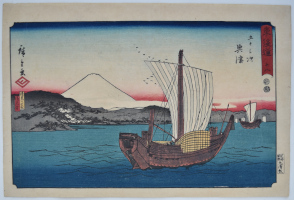
Click here to view image full size.
Station Okitsu from a set Tokaido gojusan tsugi, “The Fifty-three Stations of the Tokaido Road,” aka the Reisho Tokaido from the clerical script used in the title, or the Marusei Tokaido after the publisher Maruya Seijiro (Marusei) who published the set 1847-52. The Kiyomi Barrier and Seiken Temple near Okitsu.
Very fine impression. Fine colour and condition. Signed Hiroshige ga.
Status: Available
Utagawa HIROSHIGE (1797-1858)
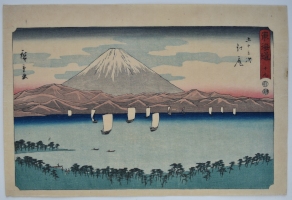
Click here to view image full size.
Station Ejiri from a set Tokaido gojusan tsugi, “The Fifty-three Stations of the Tokaido Road,” aka the Reisho Tokaido from the clerical script used in the title, or the Marusei Tokaido after the publisher Maruya Seijiro (Marusei) who published the set 1847-52. Located on the west side of Suruga Bay, close to the famous beauty spot of Miho no Matsubara.
Very fine impression. Fine colour and condition. Signed Hiroshige ga.
Status: Available
Utagawa HIROSHIGE (1797-1858)
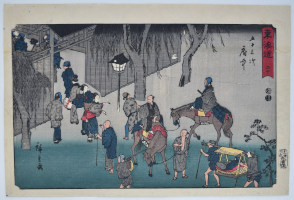
Click here to view image full size.
Station Fuchu from a set Tokaido gojusan tsugi, “The Fifty-three Stations of the Tokaido Road,” aka the Reisho Tokaido from the clerical script used in the title, or the Marusei Tokaido after the publisher Maruya Seijiro (Marusei) who published the set 1847-52. A night scene with travellers arriving at an inn. This was the largest post town on the Tokaido and served as the castle town for Sumpu Castle, the seat of the Tokugawa clan.
Very fine impression. Fine colour and condition. Signed Hiroshige ga.
Status: Available
Utagawa HIROSHIGE (1797-1858)
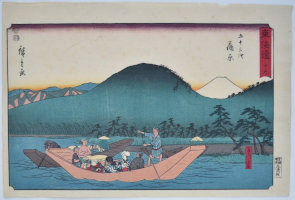
Click here to view image full size.
Station Kanbara from a set Tokaido gojusan tsugi, “The Fifty-three Stations of the Tokaido Road,” aka the Reisho Tokaido from the clerical script used in the title, or the Marusei Tokaido after the publisher Maruya Seijiro (Marusei) who published the set 1847-52. Kanbara, Fujikawa funawatashi, “Kanbara, Ferryboat on the Fuji River.”
Very fine impression. Fine colour and condition. Signed Hiroshige ga.
Status: Available
Tsukioka YOSHITOSHI (1839-1892)
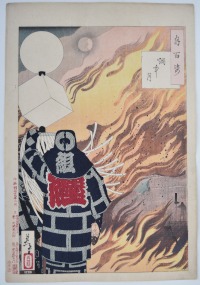
Click here to view image full size.
A silhouetted fireman faces a conflagration; in his left hand he holds a matori, a three-dimensional standard which identifies him and his location. Enchu no tsuki, “Moon and Smoke” from Tsuki hyakushi, “One Hundred Aspects of the Moon.” Published by Akiyama Buemon (Akiyama Seikichi) 1885-1892, this being 1886. The firemen’s heavily-quilted jackets were soaked in water to better enable them to withstand the heat. They were notorious for their rowdy behaviour and rivalrous nature leading to open hostility with other groups such as sumo wrestlers. Fires were a constant threat due to the building materials used, and firefighters were not above starting fires themselves in order to be the first on the scene (especially if they were in the construction business).
Fine impression, colour and condition. Signed Yoshitoshi. A gourd-shaped collector’s seal (unread) in the extreme left bottom which is found on other early impressions of this set.
Status: Available
Tsukioka YOSHITOSHI (1839-1892)
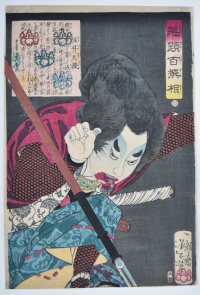
Click here to view image full size.
The boy warrior Sakai Kuzo hurling a te-yari spear from a set Kaidai hyaku senso “Yoshitoshi’s Selection of One Hundred Warriors.” Sixty-five prints published by Ohashiya Yashichi (Odawaraya Yashichi) between 1868 and 1869, this being 1868. The text in the square cartouche in this set refers to prominent warriors in the internecine wars of the 16th century, but in fact the subjects are Shogitai soldiers (those that held out against the Imperial forces and were massacred at Ueno, 4/7/1868). An excellent set.
Fine impression, colour and condition. Signed Ikkaisai Yoshitoshi hitsu.
Status: Available
Tsukioka YOSHITOSHI (1839-1892)
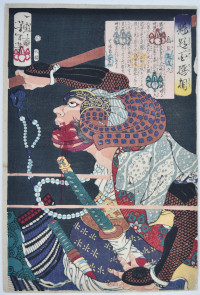
Click here to view image full size.
Shows Shima Sakon Tomoyuki at the battle of Sekigahara, October 21, 1600. Shima was a commander of Ishida no Mitsunari’s forces against Tokugawa Ieyasu and was shot by riflemen (although his body was not found). He is shown being hit by a hail of bullets, his juzo (rosary) swinging in the air. From a set Kaidai hyaku senso “Yoshitoshi’s Selection of One Hundred Warriors.” Sixty-five prints published by Ohashiya Yashichi (Odawaraya Yashichi) between 1868 and 1869, this being 1868. The text in the square cartouche in this set refers to prominent warriors in the internecine wars of the 16th century, but in fact the subjects are Shogitai soldiers (those that held out against the Imperial forces and were massacred at Ueno, 4/7/1868). An excellent set.
Fine impression, colour and condition. Signed Ikkaisai Yoshitoshi hitsu.
Status: Available
Utagawa KUNISADA (1786-1864)
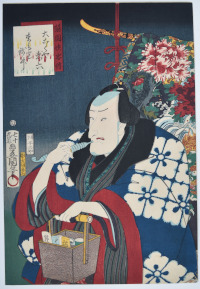
Click here to view image full size.
The actor Matsumoto Koshiro VI as the otokodate (a roguish yet honourable character) Daikokuya Soroku from a set Rien kyokaku-den, “The Story of a Chivalrous Man of the Theatrical World.” The set published by Hiranoya Shinzo (Hirashin) 1864. Soroku is the owner of a house of assignation called Daikokuya in the Shin-Yoshiwara. This is from the de-luxe edition employing only the finest pigments, block-cutting and printing. (The block-cutter was Ota Komakichi – highly regarded.) There are later editions without the embellishments. Some other late Kunisada sets have the same enrichments, such as the so-called Famous Actors Past and Present set.
Extremely fine impression on thick hosho with burnishing and kimetsubushi (or mokume-zuri) on the wooden box he is carrying. Extremely fine colour. Slight trimming, otherwise fine condition. Signed nanajukyu sai Toyokuni hitsu, “Drawn by the 78 year old Toyokuni.”
Status: Available
Utagawa KUNISADA (1786-1864)
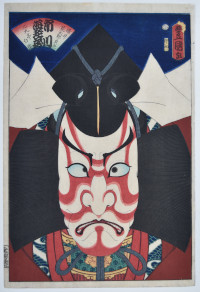
Click here to view image full size.
The actor Ichikawa Ebizo V (Ichikawa Danjuro VII) in a Shibaraku scene as the warrior Usui Arataro Sadamitsu (Taira no Tadamichi) adopting the cross-eyed mie expression to show great emotion. From an untitled set of large-head portraits of actors, past and present, published by Ebisuya Shoshichi (Kinshodo) between 1860 and 1865, this being 1860. Kunisada, in his old age, planned this set to have 150 designs but only 72 were completed (with the help of Utagawa Yoshitora). Only the best materials and most experienced engravers and printers were employed, the cost being mitigated by the Mitani copper and iron merchant family.
Fine impression with heavy burnishing on the hair. Very slight fading, otherwise very good colour. Very good condition. Signed Toyokuni ga.
Status: Available
Utagawa KUNIYOSHI (1797-1861)
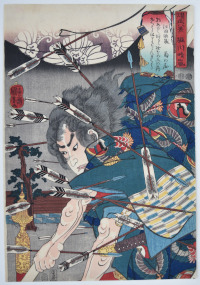
Click here to view image full size.
The warrior Eda Genzo Hirotsuna avoiding a hail of arrows during the defence of Minamoto Yoshitsuna’s palace at Horikawa, Kyoto in 1185. He was killed during the night attack. Horikawa seiran, “Clearing Weather at Horikawa” from the set Yobuhakkei, “Military Brilliance for the Eight Views.” Each of the eight prints has an association, either pictorially, thematically or by place with the famous Eight Views originating from China. Published by Enshuya Hikobei (Enhiko) 1852. Unidentified collector’s seal au verso.
Very fine impression, colour and condition. There are later states lacking the subtleties of the first printings. Signed Ichiyusai Kuniyoshi ga.
Status: Available
Keisai EISEN (1790-1848)
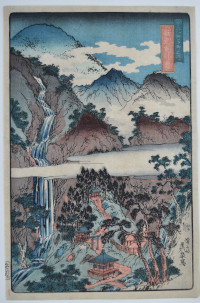
Click here to view image full size.
Jakko Nunobiki no taki, “The Hanging Cloth Waterfall at Jakko Shrine.” So-called because it falls in seven-tiers. The shrine is seen below the fall. From a set of five prints: It was probably intended to be a set of three prints but another two were added, possibly with the intention of going on to emulate Hokusai’s waterfall set. Nikkosan meisho no uchi, “Celebrated Views in the Nikko Mountains.” Published by Yamamotoya Heikichi (Eikyudo) c. 1843-47. In contrast to Hokusai’s set, Eisen’s have a more muscular appearance. See: The Japanese Print: A New Approach, J. Hillier, Bell & Son, 1960, Chapter XVI, where Jack Hillier discusses Eisen and his landscapes and considers this set “… is perhaps the crowning achievement of his career as a designer of landscape prints.”
Fine impression. (Late impressions are not known of this set, probably due to not having the popularity of Hokusai’s set.) Slight fading, otherwise very good colour. Very good condition. Signed Keisai Eisen utsusu.
Status: Available
Keisai EISEN (1790-1848)
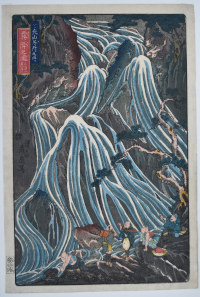
Click here to view image full size.
The Kirifuri waterfall, Kirifuri no taki, santaki no sono ikkei, “The Falling Mist Waterfall, View of One of the Three Falls.” From a set Nikkosan meisho no uchi, “Celebrated Views in the Nikko Mountains.” A group of travellers admire the fall from below. From a set of five prints: It was probably intended to be a set of three prints but another two were added, possibly with the intention of going on to emulate Hokusai’s waterfall set. Published by Yamamotoya Heikichi (Eikyudo) c. 1843-47. In contrast to Hokusai’s set, Eisen’s have a more muscular appearance. See: The Japanese Print: A New Approach, J. Hillier, Bell & Son, 1960, Chapter XVI, where Jack Hillier discusses Eisen and his landscapes and considers this set “… is perhaps the crowning achievement of his career as a designer of landscape prints.”
Fine impression. (Late impressions are not known of this set, probably due to not having the popularity of Hokusai’s set.) Very good colour and condition. Signed Keisai Eisen utsusu.
Status: Available
Keisai EISEN (1790-1848)
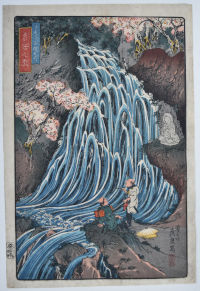
Click here to view image full size.
Somen no taki, “The Wheat Noodle Waterfall.” From a set Nikkosan meisho no uchi, “Celebrated Views in the Nikko Mountains.”Two travellers admire the fall from below. On a ledge above them is a stone statue of Jizo Bosatsu, the deity of travellers. From a set of five prints: It was probably intended to be a set of three prints but another two were added, possibly with the intention of going on to emulate Hokusai’s waterfall set. Published by Yamamotoya Heikichi (Eikyudo) c. 1843-47. In contrast to Hokusai’s set, Eisen’s have a more muscular appearance. See: The Japanese Print: A New Approach, J. Hillier, Bell & Son, 1960, Chapter XVI, where Jack Hillier discusses Eisen and his landscapes and considers this set “… is perhaps the crowning achievement of his career as a designer of landscape prints.”
Fine impression. (Late impressions are not known of this set, probably due to not having the popularity of Hokusai’s set.) Fine impression. Very good colour. Slight edge soil, otherwise very good condition. Signed Keisai Eisen utsusu.
Status: Available
Keisai EISEN (1790-1848)
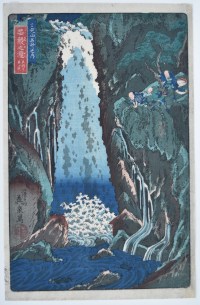
Click here to view image full size.
Kegon no taki, santaki no sono ikkei, “ The Kegon Waterfall, View of One of the Three Falls.” From a set Nikkosan meisho no uchi, “Celebrated Views in the Nikko Mountains.” Three travellers rather precariously perched on a ledge looking down at the fall. From a set of five prints: It was probably intended to be a set of three prints but another two were added, possibly with the intention of going on to emulate Hokusai’s waterfall set. Published by Yamamotoya Heikichi (Eikyudo) c. 1843-47. In contrast to Hokusai’s set, Eisen’s have a more muscular appearance. See: The Japanese Print: A New Approach, J. Hillier, Bell & Son, 1960, Chapter XVI, where Jack Hillier discusses Eisen and his landscapes and considers this set “… is perhaps the crowning achievement of his career as a designer of landscape prints.”
Fine impression. (Late impressions are not known of this set, probably due to not having the popularity of Hokusai’s set.) Fine impression. Very good colour. Slight edge soil, otherwise very good condition. Signed Keisai Eisen utsusu.
Status: Available
Kitagawa UTAMARO (1753-1806)

Click here to view image full size.
A pillar print showing the courtesan Ariwara and her young attendant Arishige (below), both of the Tsuruya House. Utamaro’s output of hashira-e was not as great as some other artists, and they are especially difficult to find in good condition because of often being hung on pillars and in alcoves where they were subject to fading and toning. Another trimmed and somewhat faded impression is in the B.M. 1907, 0531, 0. 474. Published by Matsuyasu , c. 1803.
Fine impression. An area of slight fading of purple at centre, otherwise extremely well retained colour. Very good condition. Signed Utamaro hitsu.
Status: Available
Tsukioka YOSHITOSHI (1839-1892)
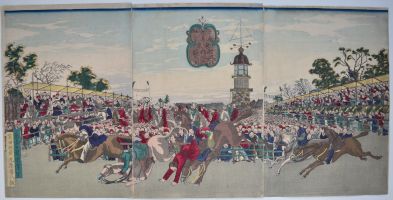
Click here to view image full size.
A triptych showing horse racing in Tokyo. Tokyo Shokonsha [the original name of the Yasukuni Shrine] naigaijin keiba no zu, “Horse Racing for Foreigners and Japanese in Shokonsha Tokyo.” From Tokyo kaika kyoga meisho, “Comic Pictures of Civilised Tokyo.” Published by Maruya Jinpachi (Marujin) 1871. The first Western-style horse racing was established by – mainly British – residents in the form of the Yokohama Race Club in 1862.
Fine impression: Later states lack the wood-pattern background on the title panel. Fine colour and condition. Signed Oju Keisai Yoshitoshi.
Status: Available
Utagawa YOSHITSUYA (1822-1866)
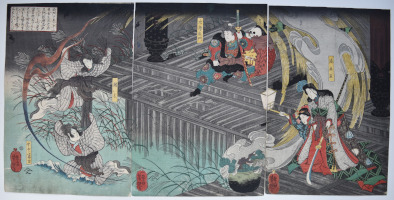
Click here to view image full size.
A triptych Uto Yasukata chugi den, “The Tale of Faithful Uto Yasukata.” Shows Shogun Taro Taira no Yoshikado (centre); Princess Takiyasha right); and Uto Yasukata and his wife (far left) turning into birds. Set in the ruins of Soma Palace. Takiyasha releases a ghost from a cauldron. A difficult triptych to interpret. (More information is available on the Lyon collection website: woodblockprints.org.) Published by Tsujiokaya Bunsuke (Tsujibun) 1852-53.
Fine impression and colour. Small edge binding holes on centre sheet, otherwise very good condition. Signed Ichieisai Yoshitsuya ga.
Status: Available
